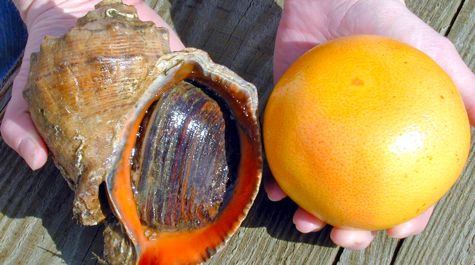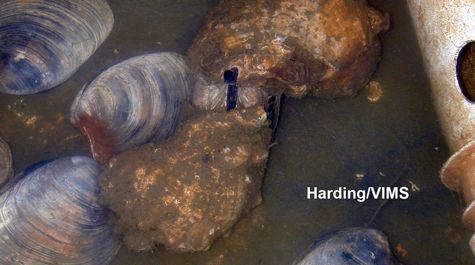Funding cut for rapa whelk bounty program
Funding for the rapa whelk bounty program at the Virginia Institute of Marine Science was eliminated in state budget cuts announced last week.
The program, in operation since September 1998, was instrumental in mapping the distribution of these invasive predatory snails, which are native to the Sea of Japan. Rapa whelks were first discovered in Chesapeake Bay in July of 1998 by members of the VIMS trawl survey during a tow through the waters of Hampton Roads.
Concern about the spread of rapa whelks in Chesapeake Bay is based on their reputation as voracious predators of oysters, clams, and other bivalves. Dr. Juli Harding, the VIMS researcher in charge of the bounty program, says “Because rapa whelks have damaged bivalve stocks in other habitats that they have invaded, we remain concerned as to their potential impacts on the hard clam and oyster populations in the region.”
Harding announced the bounty program's end in a letter sent last week to everyone who has donated a whelk to VIMS during the past 11 years. She notes that program scientists will continue to accept whelks, but will be unable to pay for them or pick them up. While funded, the program paid a bounty of $5 for each live rapa whelk and $2 per dead rapa whelk submitted to VIMS personnel with corresponding collection information.
The cuts were made by the Virginia Marine Resources Commission as ordered by Governor Timothy M. Kaine. During its operation, the bounty program had been funded through VMRC, initially via its Virginia Saltwater Commercial Fishing Development Fund, as well as by VIMS, the Virginia Sea Grant Program, and the National Fish and Wildlife Foundation.
In the letter, Harding thanked the more than 200 watermen who have participated in the program, noting that “the cooperation of local watermen, seafood processors, and private citizens made the bounty program both possible as well as a national and international model of successful collaboration between citizens and scientists.”
Harding and colleagues at VIMS will continue to study the whelk’s feeding, egg production, and growth rates. However, Harding says the end of the bounty program will “definitely make it more challenging” to track the ongoing spread of the snail in the Chesapeake.
“The bounty program was our best tool for studying the distribution and demographics of rapa whelks,” says Harding. “There are 300 to 400 watermen out on the water everyday. We would obviously never be able to obtain that level of sampling effort by ourselves.”
Harding notes that the end of the bounty program will also remove an important control measure on the rapa whelk’s population. To date, bounty-program participants had submitted more than 18,000 animals to VIMS.
The bulk of rapa whelks have been collected from Mobjack Bay south to the Bay mouth including the lower James and York rivers. A single adult rapa whelk was collected near Tangier Island in 2005. It remains to be seen if there is an established population of whelks in this region.
Professor Roger Mann, who heads the Molluscan Ecology Program at VIMS, says the large size of the initial whelk collected by VIMS researchers in 1998 indicates that the species had been introduced to the Bay several years earlier, most likely in ballast water from a ship inbound from the Black Sea or the Mediterranean—major trading partners for the port of Norfolk.
Rapa whelks were introduced into the Black Sea in the 1940s, and later spread to the Mediterranean. In the Black Sea, rapa whelks proved to be tolerant of low oxygen conditions and water pollution, and are thought to have caused the near extinction of several previously abundant shellfish species.
In addition to adult specimens, researchers and watermen have also reported rapa whelk egg cases from the lower Chesapeake. The egg cases resemble small mats of yellow shag carpet and are quiet distinctive and noticeably different from the egg cases of native snails. The presence of the egg cases in the Bay indicates that the local population of rapa whelks is reproductively active.
Harding stresses that VIMS researchers are still accepting rapa whelks despite the end of the bounty program. She says, “If someone thinks they have found a rapa whelk, they can still donate it by bringing it to the VIMS Information Desk in Waterman's Hall Monday through Friday between 9 a.m. and 4 p.m.”
Detailed information concerning rapa whelk research and reporting are available on the VIMS website.



